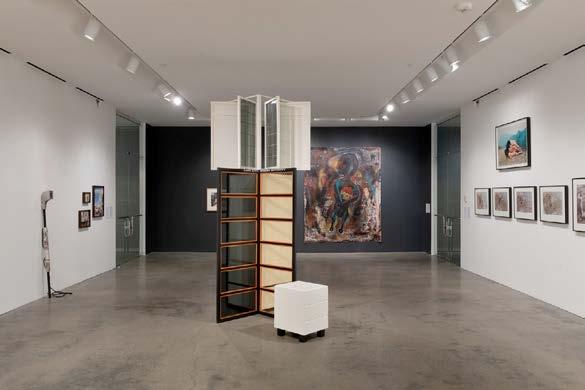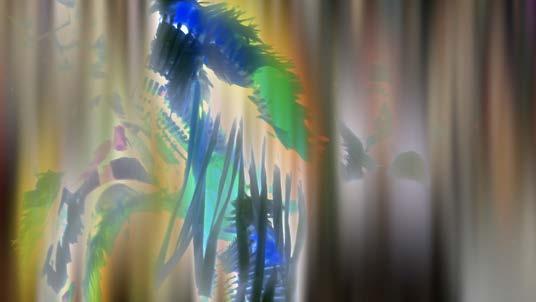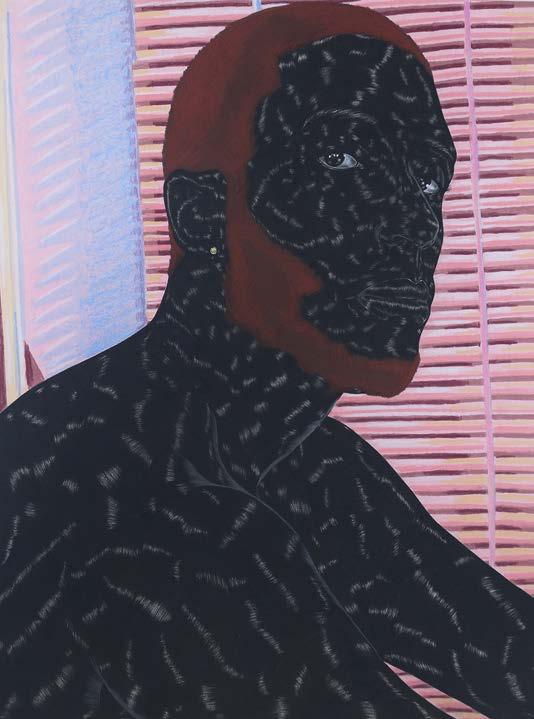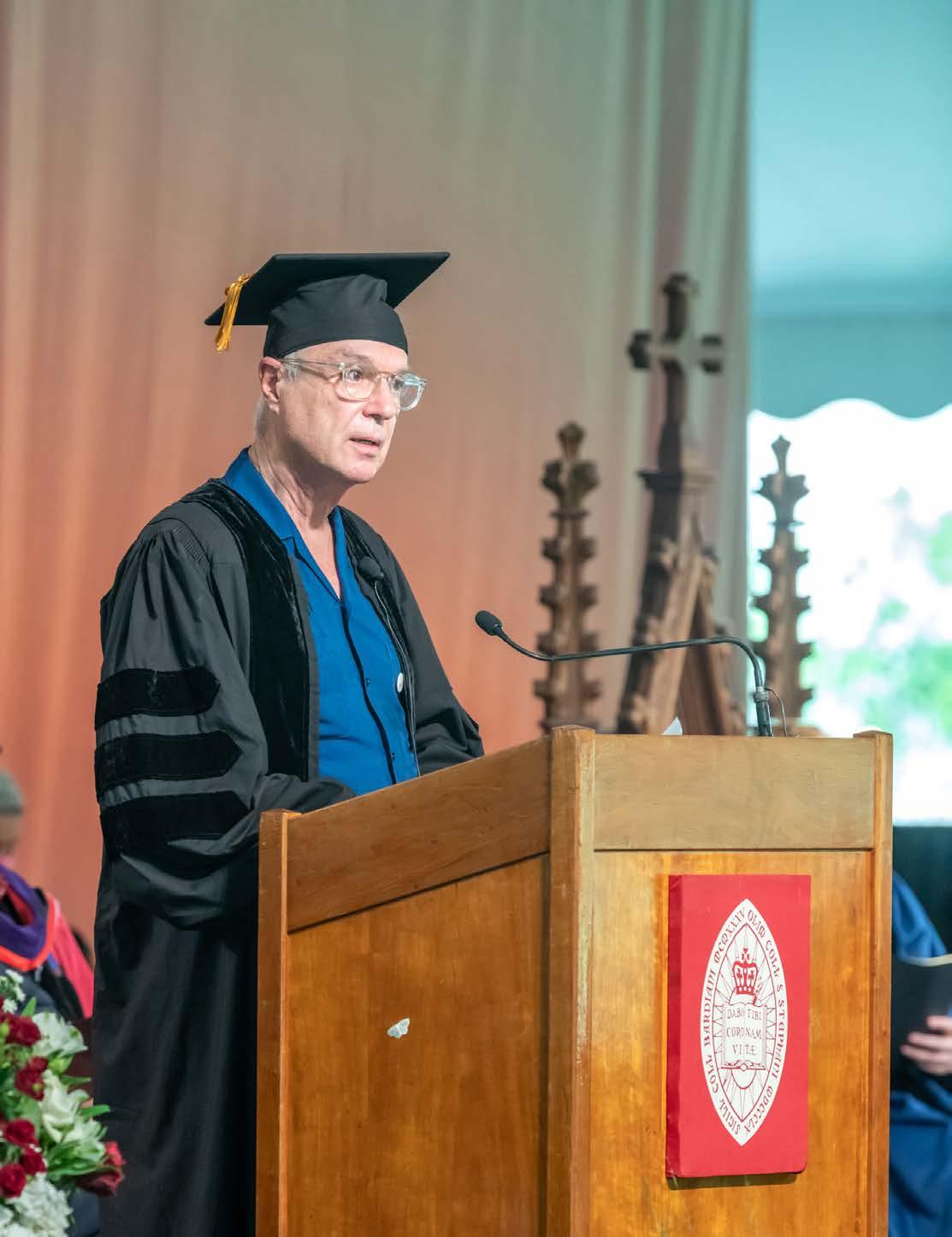
13 minute read
Leading the Way
CCS BARD AT 30
Leading the Way
by Orit Gat CCS ’11
A tradition was born one night at an impromptu dinner when the conversation turned to an exhibition someone was organizing. Around the table we discussed possible titles, artist selection, who the audience would be, what the wall text should say—it felt familiar and rigorous. At a certain point a realization occurred: we were all graduates of the Center for Curatorial Studies (CCS) at Bard College. Those dinners soon expanded to include almost a generation of alumnae. Some of us were meeting for the first time, others had worked or studied together. Some lived in New York City, and at times we organized dinners because one or more of us were in from out of town. Sometimes people came with experiences or ideas they wanted to discuss, sometimes we just talked about exhibitions we’d seen. It was a natural outgrowth of one of the most important things CCS gave us: a community.
In a black-and-white photo taken in 1988 at art collector and patron Marieluise Hessel’s country home in Wyoming, Leon Botstein, who had at that point been Bard’s president for a little more than a decade, is seated at a small table dominated by a boxy “laptop” computer. He is working on an initial proposal for a future museum and graduate school at Bard. It would carry Hessel’s name and involve a group of students working with and around her collection.

From the Collection: First Year Practicum 2019 is comprised of four exhibitions, each drawn from the Marieluise Hessel Collection. Curated in groups by the 14 MA candidates in the class of 2021, the exhibitions examine the collection through themes of migration, race, transformation, and pain. Above image: throbbing_quivering_pulsing_beating gives language to the sensorial dimensions and rhythmic patterns of pain and pleasure in the body. Curated by Natasha Matteson, Christine Nyce, Camila Palomino, and Candice Strongwater. Top of Article image: Persons in the Presence of a Metamorphosis includes a diverse range of artistic approaches that grapple with various forms of transformation, emphasizing the importance of remaining receptive to change, difference, and possibility. Curated by Krista Alba, Caitlin Chaisson, Jenni Crain, and Liv Cuniberti. Installation photos Chris Kendall ’82

But the skin of the earth is seamless proposes an approach to global migration that focuses on its generative and creative potential. Curated by Yihsuan Chiu, Bernardo Mosqueira, and Allie/A.L. Rickard.

White people are___ asks viewers to consider how whiteness has operated in the featured artists’ practices, and how that identity has been implicated, or not, in discussions of their work. Curated by Paulina Ascencio Fuentes, Georgie Payne, and Gee Wesley.
Hessel began collecting art in her mid 20s, an extraordinarily young age. In a recent interview with Tom Eccles, executive director of CCS and the Hessel Museum of Art since 2005, she explains that the people she was meeting at the time—gallerists, artists, and curators—were all about the same age as her, so seeing, talking about, and buying art were integrated into her daily life. Hessel went on to assemble a world-class collection, full of masterpieces by artists like Valie Export, Donald Judd (a six-unit wall piece is on loan to MoMA for a major retrospective of the artist’s work), Robert Mapplethorpe, Nam June Paik, and Felix González Torres. As Eccles notes in the interview, which he conducted for the forthcoming catalogue raisonné of the collection, there are works that are still challenging today. Hessel says in response that when she bought German painter Imi Knoebel’s Kite Room (1971), a painting in white acrylic on an unusually shaped piece of wood, her husband joked that she was now collecting “ironing boards.”
Hessel had always imagined her collection would eventually go to a museum in a small town. It was Botstein who convinced her that place should be Bard College, where it would be displayed, but would also be used by students. That is how the world’s first degree-granting program in curating was born. In October 1990, Botstein organized a meeting at the Century Club in Manhattan with a group of curators, art historians, and writers who formed a committee to advise on what a graduate school for curators should be. Among those convened were Norton Batkin, who went on to be the first director of the new institution and was Bard’s dean of graduate studies from 2006 to 2020; art historian Benjamin Buchloh; art critic Arthur Danto; and former Artforum editor-in-chief Ingrid Sischy. (A transcript of that meeting is in the CCS archives.)
So what should an academic program in curating be? The answer will change over time; it already has. Over these three decades, graduates have gone on to become institutional and independent curators, museum directors, PhD students in art history and other cultural fields, artists, art critics, and more. “CCS’s educational philosophy is a history of exhibitions, which by nature means a history of audiences, reception, and the shifting politics around art and display,” says art critic and professor Wendy Vogel ’09. (All class years in this article refer to CCS graduation.) “CCS also takes into account how developments such as feminism and post-colonialism inform not just art but its presentation,” she adds. Vogel says that when she was studying, at the end of George W. Bush’s second term as president and after Obama was elected, when the art world was enthralled with formalism rather than political urgencies, she felt her CCS education prepared her to think of art politically, in an engaged way that went beyond aesthetics.
The program is meant to provide both practical and theoretical training in contemporary art, and it has been around long enough for its curriculum to change. Ann Butler, director of library and archives at CCS and the Hessel Museum, describes how, in the first 12 years of the institution’s history, a crucial part of first-year practical studies course was the assembling of binders documenting specific exhibitions. These included photocopied reproductions, photographs, and other institutional matter about past exhibitions. The assignment was discontinued in 2009, but the work by those students—the Exhibition History Study Collection—is part of the library’s holdings. Now exhibition histories are taught with much more focus on students conducting archival research and looking more closely at primary information. CCS is both adjusting and leading the conversation about what a curatorial education is.
When I was a student at CCS, classes took place in seminar room 1. It had no windows. I can’t remember what seminar room 2 was like—I think it was mainly used for small electives and film screenings—but I assume it also had no windows. I remember being so jealous of students who came after me and the construction of seminar room 3. It has three huge windows and is still referred to by many people as “the sun room.” Vitamin D deficiency notwithstanding, spending two years talking about art and theory in a windowless room with some of the smartest people I’ve ever met was a privilege.
Of course it wasn’t all dim rooms and binders: during the first year of the program there is a group research trip abroad to see an international art exhibition. It’s a bonding experience and a point of access to an increasingly international art world. Sarah Higgins, now editor-in-chief of Art Papers, says that the research trip, to Germany, was the first time she left the United States. “This was, for me, a moment of heightened class awareness,” she says. “I was the only student in my cohort without a passport. That experience of traveling internationally was totally liberating and empowering.”
In our correspondence, Higgins and I found ourselves talking, again, about the opportunities the school has given us—in fact, most of the alumni/ae I talked to emphasized how CCS had helped them get through contemporary art’s hard-to-open doors. I couldn’t imagine writing about art without the conversations I had with my cohort, at school and after. And I couldn’t imagine my life as an art critic without following the development of other CCS alumni/ae who are now curating biennials (Gabi Ngcobo ’10, 2018 Berlin Biennial; Manuela Moscoso ’11, Liverpool Biennial 2020); curating at institutions in New York (Kelly Taxter ’03, Jewish Museum; Sohrab Mohebbi ’10, SculptureCenter, who in July was named curator of the 2022 Carnegie International), Los Angeles (Anne Ellegood ’98, Hammer Museum; Summer Guthery ’09, JOAN), and abroad (Sofia Hernández Chong Cuy ’00, Witte de With Center for Contemporary Art, Rotterdam; Chen Tamir ’07, Center for Contemporary Art Tel Aviv), and running residency programs, art magazines, art schools, and other institutions.
One of the stepping stones of the program is a series of meetings with a committee made up of faculty members, curators, artists, and theorists active in the contemporary art field who debate, approve, and critique students’ thesis projects. The thesis project involves a written dissertation and an exhibition at the CCS Galleries for which students work with artists directly, with artworks drawn from the Hessel Collection, or with a combination of the two. The experience of working in a professional museum—the beautiful spaces, the professional team of art installers, the advice from classmates and feedback from faculty and graduate committee—is unique to CCS. So is the opportunity to work with Hessel’s collection, which carries with it an insistence that contemporary curating is not ahistorical, and that work made today can and should be read in the context of work made 10, 20, or 40 years ago. Though some students have opted to work outside the CCS Galleries, commissioning public artworks for outdoor spaces like the Rhinecliff Amtrak station (Michelle Hyun ’11), or editing books. Özge Ersoy ’10, now public program lead at Asia Art Archive in Hong Kong, for example, edited a book, How to Begin? Envisioning the Impact of Guggenheim Abu Dhabi, engaging with questions of the Guggenheim’s future effect on the region.
Most of the curatorial degree programs that have sprung up in recent years include an exhibition component, usually a group show that the entire cohort works on collaboratively. The 2013 CCS class decided they wanted to do something closer to that. The result was Less Like An Object More Like The Weather, a single exhibition in which all the individual projects came together under one title on both sides of the building: the CCS Galleries and the Hessel Museum. The title was suggested by Sarah Fritchey ’13 (now curator and gallery director at Artspace New Haven) and inspired by an interview in which John Cage describes his work with Merce Cunningham: “In an object, you can tell where the boundaries are. But in the weather, it’s impossible to say when something begins or ends.” Cora Fisher ’13, curator of visual art for the Brooklyn Public Library, described the decision to embrace collaboration as the result of “a group sentiment that we could be doing something more interesting collectively.” She adds, “The beauty of being able to negotiate systems is a big part of the education of being a curator, in the doing more so than in the theorizing.” Higgins adds that, after years of the thesis shows being separated into two sessions at the CCS Galleries, now all thesis shows happen concurrently across the entire building, so even if future classes do not conceive of their thesis exhibitions as a collective project, “our crazy one-off gambit was accidentally written into future theses.”
That shared experience, those collective negotiations, create lasting bonds. “At CCS I met some of the people who were to become colleagues and partners in many projects,” says Cecilia Alemani ’05, curator of the 2022 Venice Biennale, the world’s largest contemporary art exhibition. “One of the most rewarding aspects of the program is its community: many of your classmates and teachers will become colleagues, mentors, and coconspirators for years to come.” This year’s edition of Greater New York, MoMA PS1’s major quinquennial exhibition of art made in New York City, is curated by a team of four, three of whom went to CCS: Inés Katzenstein ’01, curator of Latin American art and director of the Patricia Phelps de Cisneros Research Institute for the Study of Art from Latin America at MoMA; Ruba Katrib ’07, curator at PS1; writer and curator Serubiri Moses ’19; and Kate Fowle, director of MoMA PS1.
Nine years after graduation, Natasha Llorens ’11, independent curator in residence at the Jan van Eyck Academie in the Netherlands says, “The relationships I still have with my cohort are some of the most valuable in my life, on both a professional and intellectual level. This applies to those I am still in close contact with and those I was never personally close to but whose work I have followed for years from a distance. I read their writing, go to their shows, look forward to their critical feedback on my shows, recommend them to artists, and pay attention to the artists they invest in. Some do the same for me, and I count on this engagement to motivate me to persistently critically reevaluate my own work.”
And this community’s impact goes beyond itself, Vogel says. “I think CCS’s influence is so widespread that it has inspired not only a huge number of new curatorial programs but has also affected the discipline of art history. We should acknowledge its history as one of the very first programs that took on the studying of exhibitions and curating as disciplines, as opposed to studying individual artworks and movements.”
At the time CCS was founded, such a change in emphasis represented a paradigm shift. That focus seems more pertinent and important than ever. “Today you can follow every artist, gallery and museum activity on the internet,” Hessel says in her interview with Eccles, “As soon as an artist gets a good write-up, you have to buy. People buy art online. When I began collecting, I got all my information by visiting galleries, talking to gallery owners, and visiting museum shows. Great curators led the way and told us what art was.” Thirty years after the founding of the institution that carries her name, and the graduate program that was designed to expand it, CCS keeps proving that great curators can still lead the way, in dialogue with each other.
Orit Gat ’11 is a writer living in London. She’s a contributing editor at The White Review and has written about contemporary art and digital culture for a slew of magazines. In 2015, Gat won the Creative Capital/Warhol Foundation Arts Writers Grant for short-form writing. Her forthcoming book looks at soccer as a prism through which to explore questions about immigration, nationalism, race, gender, money, and love.
The Center for Curatorial Studies Exhibitions
The Center for Curatorial Studies at Bard (CCS Bard) celebrates its 30th anniversary this year and had three major exhibitions planned; all have been rescheduled. A full-scale survey of the groundbreaking but understudied Pattern and Decoration (P&D) art movement, With Pleasure: Pattern and Decoration in American Art 1972–1985, will be on view at the Hessel Museum of Art from June 26 through November 28, 2021. P&D defied the dominance of modernist art by embracing the much-maligned category of the decorative and forms traditionally coded as feminine, domestic, ornamental, or craft based. P&D artists adopted motifs, color schemes, and materials from the decorative arts, freely appropriating floral, arabesque, and patchwork patterns and arranging them in intricate, and sometimes purposefully gaudy designs. Their work evokes a diverse array of sources from Islamic architectural ornamentation to American quilts, wallpaper design, Persian carpets, and Japanese Imari ware. Shaped and driven in large part by the development of feminist art-historical methods, P&D sought to create an art based on aesthetic and political principles of inclusion. Originally on view at MOCA Grand Avenue and organized by MOCA curator Anna Katz, with assistant curator Rebecca Lowery, the exhibition will be accompanied by a fully illustrated, scholarly catalogue published in association with Yale University Press.
Sky Hopinka: Centers of Somewhere, curated by Lauren Cornell, director of the CCS Bard Graduate Program and chief curator, is on view in the CCS Bard Galleries through February 14, 2021. Centers of Somewhere presents a newly commissioned, multichannel work by Sky Hopinka alongside a selection of his recent videos. A member of the Ho-Chunk Nation, Hopinka, who recently joined the Bard faculty as assistant professor of film and electronic arts, is best known for videos that center on personal positions of indigenous homeland and explore language as a container of culture. A poet and writer as well, he is deeply invested in the revitalization of indigenous language. CCS Bard copublished a book of Hopinka’s writings, titled Perfidia, with Wendy’s Subway, a non-profit reading room, writing space, and independent publisher. The book features an essay by Julie Niemi CCS ’17 and a foreword by Cornell.
Closer to Life: Drawings and Works on Paper in the Marieluise Hessel Collection, curated by Tom Eccles (CCS Bard executive director), Amy Zion CCS ’12 (visiting faculty), and Cornell, will be on view at in the CCS Bard Galleries in celebration of CCS Bard’s 30th anniversary from June 26 through October 17, 2021. This exceptional survey of drawings and works on paper from the Marieluise Hessel Collection will feature some 75 drawings by 50 artists spanning more than four decades of collecting by philanthropist Marieluise Hessel, cofounder of CCS Bard. Closer to Life focuses, with a few exceptions, on drawing as a discrete, stand-alone practice and preoccupation of artists rather than as a tool to create studies for works in other mediums. The exhibition will be accompanied by a comprehensive, fully illustrated, 380-page catalogue.

Robert Kushner, Fairies, 1980 Acrylic on canvas With Pleasure: Pattern and Decoration in American Art 1972-1985 Marieluise Hessel Collection. Photo: Chris Kendall ’82

Sky Hopinka, I’ll Remember You as You Were, not as What You’ll Become, 2016 Total run time: 12:32. HD video, stereo, color Sky Hopinka: Centers of Somewhere

Toyin Ojih Odutola, Looking at the Sunrise and Calling it Dusk, 2016 Charcoal, pastel, and pencil on paper Closer to Life: Drawings and Works on Paper in the Marieluise Hessel Collection Marieluise Hessel Collection. ©Toyin Ojih Odutola. Courtesy of the artist and Jack Shainman Gallery, New York








